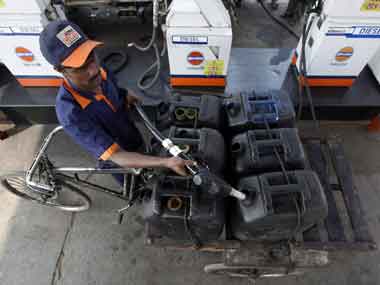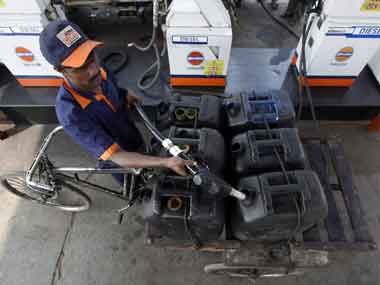By R Jagannathan
The search for a sensible petroleum pricing policy is always a search for second- and third-best solutions in India’s political economy.
For one, a solution is being sought only because the fiscal deficit of Pranab Mukherjee is so high that his subsidies can no longer be hidden in some footnote of the budget papers (Rs 1,38,500 crore in 2011-12). For another, since this subsidy is shared by three listed public sector entities - ONGC, Oil India and Gail - and investors are unhappy with this loot of their resources , the UPA government is doubly forced to act. Third, since oil is our biggest import ($150 billion last year), and its consumption is not going down, our import bills are rising just as our foreign exchange inflows are tapering off. Result: the rupee is down to less than 55 to the dollar.
[caption id=“attachment_323618” align=“alignleft” width=“380” caption=“Petrol woes. Reuters”]
 [/caption]
[/caption]
The decision to raise petrol prices by nearly Rs 7.50-8 a litre has come after this push, prod and shove from reality. However, politicians don’t like it one bit, and there is already talk of rolling back the petrol price hike after a few weeks.
Here’s a quick review of how politicians are opting for lousy solutions and non-solutions to avoid the public heat. Let’s start with the recent petrol price hike.
On Monday, almost all newspapers carried stories on how states were taxing petrol too much, and why they must cut these taxes.
This is true. In Mumbai, for example, 18.8 percent of the petrol price of Rs 78.57 is central tax and 21.3 state tax. Together they account for over 40 percent of the total price.
But the purpose of this information-leaked from Delhi-is to spread the political heat from Centre to states. Not to solve anything.
So, sure, states can cut taxes. But so can the Centre. But neither is a real long-term solution, for it is not right to tax fossil fuels lightly. The best alternative is to fix taxes in specific amounts (say, Rs 10 a litre, rather than 20 percent). When taxes are stated in specific amounts, they don’t ratchet up whenever prices are raised. When they are ad valorem (i.e., expressed as a percentage) they go up whenever base prices are raised. This is how a Rs 6-and-odd price hike became a Rs 7.50-7.90 increase at the petrol pump.
But even this is a second-best solution. For the real issue is the petrol-diesel price differential (Rs 78.57 a litre in Mumbai versus Rs 46 for diesel). Keeping petrol prices high does nothing to reduce oil consumption: it merely shifts consumption to diesel. The right decision is to raise diesel prices in stages - for which there is no political stomach.
Let’s take another idea, this time on diesel. Petroleum Minister Jaipal Reddy said on Monday that the government would consider taxing diesel cars higher to reduce consumption. (The demand for diesel cars spiked earlier this year precisely due to the fear that the budget would do so. But it didn’t happen).
The problem: diesel cars account for just about 10 percent of total diesel demand. Diesel is consumed by trucks and buses, farms, captive power generators and many more users.
The solution cannot be to tax diesel cars - for diesel cars are also more fuel-efficient over long distances. They may actually reduce (though not always) fuel consumption, if diesel and petrol were similarly priced.
Another second-best solution.
Now let’s consider aviation turbine fuel (ATF) - one fuel on which the oil marketing companies make some profits, not losses. To rescue the airlines, which are steeped in losses, the government has allowed them to import ATF directly.
So how does this help? All it does is help airlines avoid state taxes - which is what would happen if airlines bought domestic ATF. So the solution to help airlines is really a solution to dent state revenues. The centre is robbing the states to pay airlines.
This is not just a second-best solution, it is no solution at all.
Next, consider what is being proposed on LPG - cooking gas. The government is busy blocking people with double gas connections (nobody consumes more just because they have two or four cylinders; but they will consume less if they had to pay market prices). It has also created a transparency portal where people can track the number of subsidised cylinders sold to anyone - including themselves (See here ). The idea is that if you used three cylinders in the last six months and the portal shows six, it means some hera-pheri is going on and you can report it.
Ultimately, these portal (see here) will allow the government to limit the number of subsidised cylinders given to anyone.
This is certainly a move in the right direction, but incomplete. Limiting cylinders is fine, but simultaneously it must move to remove the better off from the list completely and also offer full-priced cylinders to anyone who does not want a subsidy. Making market-priced gas available to everybody will shift many people to non-subsidised consumption.
But politicians will be politicians.
The Business Blog is a daily business blog anchored by Firstpost senior editors. It will offer quick comments and insights into major business news developments from the pink press.
)